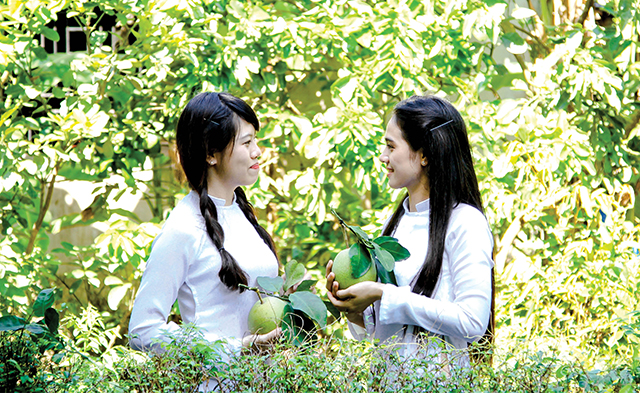
Fruit trees in Thuy Bieu
Hue lies between Hoanh Son (Hoanh mountain) and Hai Van Son (Hai Van mountain). It is the transient area with harsh climate and soil, and the appearance of “non-Vietnamese” factors. Going south was the main tendency and this land thus became an important knot which opens up a single road forming the nation of Vietnam.
The cultural heritage of the Nguyen Dynasty was created in times of difficulty, but reached its peak and become typical in Southeast Asia. It is the prudence that creates the exquisite character of a culture in which man respects his living environment through a system of Feng Shui, which is the peak of landscape art.
In difficult economic conditions, the most important character of Hue people is modesty in front of nature. Hue people focus on the depth of thoughts rather than the height. Shapes and colors in decorative art are therefore rich in symbolism and humanity. Arriving in Ai Tu in 1558, but not until 1601 did Lord Tien accessed the Perfume river, legendized and historized the Lady of Heaven in Red to build Thien Mu Pagoda, starting Buddhism in the Inner Realm.
It was the premise for the settlement in Kim Long in 1636, and Hue became the main city of the area, and the imperial capital Dai Nam of the Nguyen Dynasty. The city soon became an urban masterpiece in Asia where a unique system of court and religious values was shaped and spread.
Our ancestors relied on the Perfume river, well known for the supreme goddesses of Hai Cat Mountain, Ha Khe Hill, Thanh Phuoc, Thai Duong, and the axis that connected heaven and earth from Long Tho Hill to Ha Khe Hill, Vong Canh Hill to Hon Chen Islet… to form the urban masterpiece of Hue.
The north bank of the river became the Citadel while the south bank was land of fields and gardens, and the western region was the sacred area for pagodas, royal mausoleums and tombs. The strictness of rules combines with the sacredness of religious beliefs and people’s prudence have been nourished in a typical garden city including home gardens, pagoda gardens, princes’ and princesses’ garden residence, royal gardens and tomb gardens.
Hue Citadel was built in the Vauban style of the French, but Vietnamized to become refined and harmonious with Feng Shui principles.
In early 19th century, out of respect for the cultural heritage of the Nguyen Dynasty, the French urbanized the fields in the south into the western area with such streets as Jules Ferry (Le Loi), Mandarin (Hung Vuong) and Khai Dinh (Nguyen Hue) with the idea of a three-tier city: (1) Kim Long- the Imperial City as the center of the Nguyen Dynasty, (2) the western zone in the south and (3) the modern zone.
Regulations for a typical heritage city have been since decided to maximize the advantages of each tier of the city and emphasize the harmony in a special heritage city as warned by UNESCO about height, color, material, sound, image and symbol.
It is necessary to reproduce an aristocratic space of the Nguyen Dynasty with unique activities, handicraft works, museums, etc., make it a tourism product and use it to educate people about tradition, professional skills as well as conservation. Hue must be a big work for high-quality handicrafts, a big studio for movie shooting about the golden time of the Nguyen Dynasty. Calling for the assistance from various social forces means bringing tradition to life.
The calmness and openness of nature together with the strictness of social environment shape the careful and deep character of Hue people. It is the premise for a city in harmony with conservation and traditional value promotion with such strengths as harmony, heritage and culture tourism, yoga, meditation, etc.
Our ancestry’s spirit of harmony and peacefulness in a land of happiness should be the main spirit of the set of etiquette of a special heritage city with an emphasis on architecture, art, costume, cuisine, traditional medicine, handicrafts, etc.
In order to apply those unique values of Hue in the modern life, Hue needs a head architect with good will and strategic perspective to be able to gather the essence of Hue, those who love Hue from everywhere and to create the environment and effective policies to bring the cultural heritage into tourist products, making them best-quality products.
Hue is a well-cared garden city with exquisite and thoughtful people and strict and humane customs. It is also a center of education, especially in social sciences and humanities, medicine, clean agriculture, providing a good labor force and talented people.
More than any other places, Hue City needs to build a data bank about the history of the territory expansion of the nation, the Inner Realm - Tay Son Dynasty - Nguyen Dynasty to serve studying, reproducing, relic repairing and developing traditional crafts, which recall the works of the Nguyen Dynasty. It is necessary to study that data bank, whose results would be applied to develop tourism, produce high-quality goods, repair and conserve relics and transfer tourist technology, especially cultural tourism technology, historical and cultural festival technology, etc.
Hue boasts quintessential traditional values and is very different from others. The typical heritage city is therefore always valuable like what the French said: “Hue: ville heureuse: soeur des fées, mère des fées, filleule des fées” (“Hue: city of happiness, mother of fairies, sister of fairies, goddaughter of fairies”)
Story: Tran Dinh Hang
Photo: Bao Minh